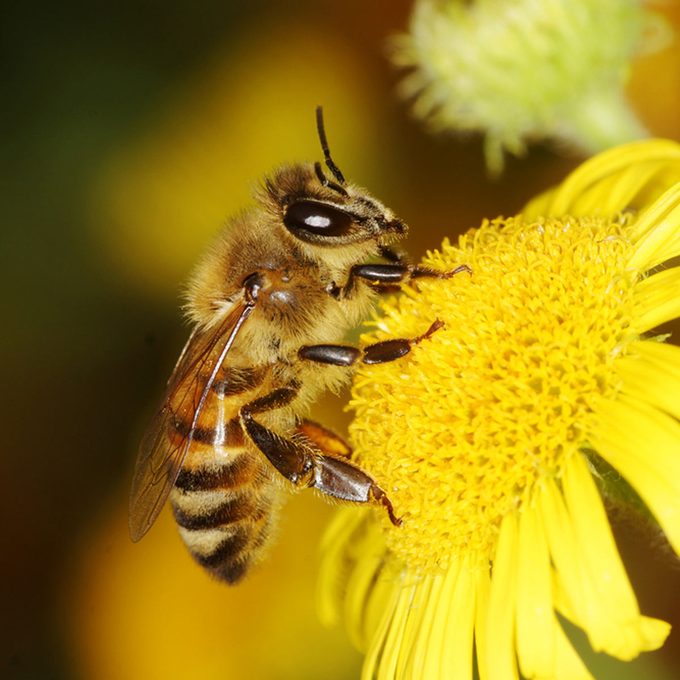10 Crazy Things You Didn’t Know About Bees
Updated: Jan. 23, 2024
Think you know everything there is to know about bees? Guess again.
While we often associate bees with the danger of an unpleasant sting, there’s so much more to bees than their sting. In fact, bees are among the most important creatures on the planet when it comes to their impact on humans and the planet’s natural ecosystems.
Bee Stings Can Cure Disease
Let’s get what we fear the most about them out of the way. The first thing you should know about bee stings is that they can actually have some benefits! A toxin in bee venom called melittin may prevent HIV, according to scientists at Washington University in St. Louis. The melittin can kill HIV by poking holes into the virus’s protective envelope.
Bee stings may also ease pain associated with rheumatoid arthritis, according to researchers at the University of Sao Paulo. The team found that molecules in bee venom increase the body’s level of glucocorticoid, an anti-inflammatory hormone.
Honeybees Help the World Go ‘Round
Now let’s move on to another common thing we associate bees with: honey! Globally, there are more honeybees than other types of bee and pollinating insects, making them the world’s most important pollinator of food crops. There are three kinds of bees in a hive: queen, worker and drone. The worker bees are all female, and perform all the work for the hive.
A beehive in summer can have as many as 50,000 to 80,000 bees, with 556 worker bees required to gather a pound of honey.
While you’re at it also see how native bees are important for your garden. Honey Bees get all the buzz, but there are dozens of native bee species hard at work who could use your help.
How to Identify Honeybees
Bumblebees are round and fuzzy; honeybees are smaller and thinner. And while honeybees have a clear distinction between head and abdomen, bumblebees are “all of one piece.” Honeybees also have two sets of wings: a larger set in front and a smaller set in back. Interested in beekeeping? Check out these 14 tips for doing it in your backyard.
Bees Produce a LOT
The average worker bee makes about 1/12th of a teaspoon of honey in her lifetime. They can also produce beeswax thanks to the special glands on their stomach that secrete wax into little pockets that they chew with their mandibles and form into a honeycomb.
Bees are the only insect in the world that make food humans can eat. Check out these bee-friendly plants to add to your yard.
Bees Are Intelligent
Now, as far as how relatable bees are to humans, there are quite a few things to take note! First of all, according to Bee America, bees see faces the same way we do, taking parts like eyebrows, lips and ears to make out the whole face. This is called configural processing.
They’re also mighty mathematicians, capable of solving what mathematicians call the “traveling salesman problem” that even stumps some computers. The traveling salesman problem asks: “Given a list of cities and the distances between each pair of cities, what is the shortest possible route that visits each city and returns to the origin city?” Researchers at Royal Holloway University in London found that bumblebees fly the shortest route possible between flowers, making them the only animals known to solve the problem.
Bees Are the Vikings of the Insect World
Bees have incredible Viking-like vision. The Vikings are believed to have navigated with sundials. On cloudy days, they used chunks of calcite as polarized filter to keep them on track. They placed the calcite in front of their eyes to darken skies, manage reflections, or suppress glare from the surface of lakes or the sea. Bees, too, use the sun as a compass. When it’s cloudy they navigate by polarized light, using special photoreceptors to find where the sun is in the sky.
Bees are Disappearing at Alarming Rates
That’s all some pretty cool stuff, right? Unfortunately, bee numbers are falling across the world due to factors such as pesticide overuse and habitat loss.
There are many ways you can help bees. Avoid using pesticides in your garden. Plant herbs and bee-friendly plants. And shop for certified organic food, since on average plant, insect and bird life is 50 percent more abundant on organic farms. And if you’re in the mood for a project, you can help protect bees by creating a bee hotel.
